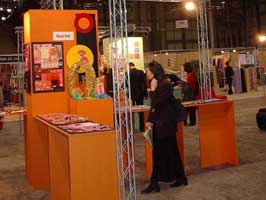Textile
trade shows

International
Fashion Fabric Exhibit, April 2001 at the Javits Center, New
York, NY |
Fabrics and new market offerings are available at textile trade shows, held once or twice annually in the United States and abroad. The International Fashion Fabrics Exhibition (IFFE) held at the Javits Center in New York is one example. Exhibitors include domestic and international fabric mills, converters, trim and fastener manufacturers, and supporting services providers such as CAD manufacturers.
 |
| The Javits Center in NYC hosts many trade shows for apparel and textiles |
Five-yard samples can be requested, or a full order can be placed, but no fabric order can be physically taken away from the show. Educational seminars and color trend information are available for a fee. Admittance to this and other shows requires advance registration. To be a full attendee you must send full company information and show a business card at registration. Students may attend as guests. For fabrics for functional outdoor apparel, the Snow Sports Industries of America show (SIA) is held in Las Vegas in January and Outdoor Retailer is held in Salt Lake City in August. Both includes fabric and trim vendors as well as finished apparel and hard goods such as skis and snowboards.
 |

 "I go to the gift show at Javits (Convention Center in New York City)" "I go to the gift show at Javits (Convention Center in New York City)"
Joan Reuning visits several trade shows to purchase clothing that complements her own designs for her retail store. These shows are potential sales venues for apparel designers.
|
Trade shows in every industry are important resources to entrepreneurs and are advertised in the trade press in either printed versions or web versions such as:
- www.apparelnews.net/TradeShows/index.html displays current trade show information and is part of an online version of a trade journal, California Apparel News.
- www.nhfa.org(National Home Furnishings Association) lists meetings, educational opportunities, and industry news.
- www.wgsn.com (Worth Global Style Network is an online business-to-business news and information service for the fashion and style industries. It reviews completed shows thoroughly and has a searchable calendar of shows for a long list of design-related categories. It requires registration and a membership fee.
 |
 
 "For ready-to-wear, we go twice a year to Paris to the Premier Vision Show. If we don't find what we need, we will commission artwork...quite often in the children's division.." "For ready-to-wear, we go twice a year to Paris to the Premier Vision Show. If we don't find what we need, we will commission artwork...quite often in the children's division.."
Diane Brush describes how designers at Garnet Hill get inspiration, hunt for fabrics, and purchase artwork that is transformed into fabric prints, novelty knits, and applied designs.
|
Shopping a wholesale market is very different than shopping as a consumer. The vendors expect their customers to be well-versed in materials as well as the wholesale environment. They can be aggressive, rude, and demanding. Here are some hints to surviving your first wholesale shopping experience.
| Hints on Shopping Wholesale  Write down what you're looking for before you go. For example, Write down what you're looking for before you go. For example,
- Fabrics needed for what products
- Desirable fiber contents and fabric constructions
- Special characteristics and performance specifications
- Preferred color or prints
- Price restrictions
- Yardage needed for each product
Decide how many different sample fabrics you want to buy. Or, how much you will spend on materials for samples and production.
 Browse the trade show before you get serious with particular vendors, fabrics, and prices. Bring a small notebook to record information about vendors and samples that interest you. Browse the trade show before you get serious with particular vendors, fabrics, and prices. Bring a small notebook to record information about vendors and samples that interest you.
 Be prepared to say "no" or to move on to the next booth. Vendors want to sell you materials. They will react to things you say and do. If you seem interested, they'll focus on the fabrics you are looking at. If you seem disinterested, they'll try to identify other materials that will interest you. Be prepared to say "no" or to move on to the next booth. Vendors want to sell you materials. They will react to things you say and do. If you seem interested, they'll focus on the fabrics you are looking at. If you seem disinterested, they'll try to identify other materials that will interest you.
 After deciding on a sample purchase, take time to discuss cost, payment, and shipping terms for a future production order. This is your opportunity to talk directly with sales representatives in person. Use the time to figure out what you will and will not be able to negotiate for and take notes for later use. After deciding on a sample purchase, take time to discuss cost, payment, and shipping terms for a future production order. This is your opportunity to talk directly with sales representatives in person. Use the time to figure out what you will and will not be able to negotiate for and take notes for later use.
 If you're ready to purchase yardage, decide what terms are best for you. Negoitate. If the terms aren't acceptable, go to another vendor-the first one will try to get you to return if further negotiations are possible. If you're ready to purchase yardage, decide what terms are best for you. Negoitate. If the terms aren't acceptable, go to another vendor-the first one will try to get you to return if further negotiations are possible.
 Remember that you are the buyer . If you prepare, you can control the purchase process Remember that you are the buyer . If you prepare, you can control the purchase process |
|





